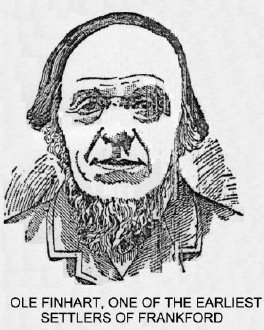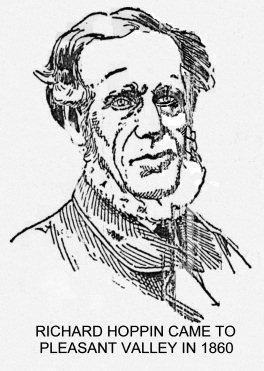|
Hon. B. F. Langworthy of Brownsdale,
April 2, 1902 We continue this week a brief summary of the history of the different townships of Mower county. There is a widespread interest in this early history and while the summary must necessarily be abridged, we are able to give quite a clear idea of the first settlements. CLAYTON TOWN, 102, 15, was one of the unfortunate townships of early days. The land was early bought by speculators and held so that settlement was very slow and when later the land was sold for cultivation, the failure of crops struck many just in the right time to discourage. For the last few years the growth of population has been rapid. The town was named from W. Z. Clayton, a native of Maine, who owned a large tract of land here. In 1864 John Johnson settled in the southwestern part, followed by Hiram Thompson, but for several years after the settlers were few. D.B. Coleman bought two section in 1868, and settled on the farm in 1877. C.P. Clayton came from Maine in 1881. T.M. Gibbs came from Wisconsin in 1879. The township was organized in June, 1873. GRAND MEADOW TOWN, 103, 15, is a prairie township. The
first settlers were Arthur McNally and Andrew McCabe. In August, 1856,
B.F. Langworthy made a claim in section 12. In the same year, S.H. Rice
Clark Erastus and Joseph Markham settled in the township in 1859. S.B. Remington settled on Section 8, William Feenendall and D. Vandenoever came in 1860. Henry Webber settled on Section 4. The town was organized in 1862 at the house of B.F. Langworthy. Chauncey Knapp, who was afterwards murdered, was one of the board. The village of Grand Meadow was laid out in 1870 as soon as the Southern Minnesota railroad had reached there. Two elevators were built in 1875 and during the years 1876 and 1877 immense quantities of grain were marketed. it is said that the freight bills of the shippers for the last four months of 1877, amounted to $22,000 per month. The Grand Meadow post office was established at B.F. Langworthy's House in 1857 and was kept there until the village was started when it was moved to the station. He was succeeded as postmaster by Rolena Dunbar who kept the office until 1884 when he was succeeded, I think, by J. Criswell. Speaking of the Finhart's reminds us of an experience which Ole O. Finhart had early in 1856. He settled on section 7, Frankford. He was a man respected by all. The following incident will give a vivid idea of the sparse settlements in pioneer days and also of some of the hardships encountered. In March, 1856, Joseph Lyons, father of H. Lyons of Lansing, was trying to get from Chatfield to Austin to visit relatives there. he had found someone to being him as far as Frankford village, but could get no farther. The farthest they would bring him was to Mr. Finhart's, the very frontier of the east side. They were afraid to go farther. Arriving at Finhart's, Mr. Lyons entreated him to pilot him to Austin offering to pay him $3 and hotel fare. There was no track of any kind to Austin. There had been heavy snow during the winter and at this time it had begun to melt and was getting soft. Every morning there was a thin crust on the snow that would bear up during the forenoon. Finhart did not know the way as he had never been to Austin, as there was no occasion then for going there much. He finally consented to go, out of compassion for the man. They started on the cold march morning, Mr. Finhart carrying Mr. Lyon's carpet bag as the latter was too feeble to carry it. To travel with a team was impossible, to walk was very dangerous as they must perish if they lost their way. There were no fences, trees or hills to guide them. The sun only was a guide when it was shining. Both of them put on snow shoes and started. They pushed on with fair success until noon when the snow became soft and it was difficult to proceed. They reached the "lone tree" and rested there. Finhart discovered a hole which had been torn in Lyon's carpet bag and called his attention to it. Mr. Lyons said that he must fix it as he had a little money in it and it might be lost out. By and by he opened it to arrange his money and counted out $1,600 in gold. Finhart then knew why the bag was so heavy. He was still obliged to carry it. They started again but the snow grew softer until as night came on Mr. Lyons sank with exhaustion when only three miles east of Austin and decided he could go no farther. Mr. Finhart knew that if he stopped there it meant death. He at last, after dark, found a claim shanty at some distance and succeeded in getting Mr. Lyons there. They prevailed on the occupant to hire the neighbor's team and take them to Austin, only a short distance farther. Mr. Lyons of course felt very thankful to Mr. Finhart for saving his life and bringing his fund of gold safely through, and every after showed his gratitude in substantial ways. PLEASANT VALLEY, 104, 15, being next west of Racine, was early sought by landseekers. Sylvester Hills and son Byron came out from Wisconsin in 1854, and made claim on section 11, returning to spend the winter. The next spring they brought out the rest of the family with them making the journey with ox teams, camping out at night on the way. He built a good log house on his claim and named the township Pleasant Valley from a village in eastern New York where he formerly lived. He died at his home in march 1862. The second settlement was made in June 1857 by John Rowley, Robert Reed and Russell Hoag. Rowley lived in his wagon from June until November, until his log house was built.
Many of the old settlers will remember that his house for many years was a stopping place for travelers going from Rochester and High Forest to Austin. Richard Hoppin, a native of Rhode Island, came out to Wisconsin in 1838 and in 1860 came with his family to Pleasant Valley. Thomas F. Wallace also came the same year, settling on section 15. W.L. Stiles, who came out from Vermont to Wisconsin in 1857, came to Pleasant Valley in 1864. The township was organized in 1858, Delazon S. Ketchum being the first chairman of supervisors. The first school in the town was taught by Caroline Hoag in 1858, in a little cabin 12x12, which is said by old settlers to have served a double purpose, being used for a school house during term time and being rented for a preemption shanty for the rest of the time, one settler using it until he had proved up, and then hauling the shanty to another claim to rent for a similar purpose. Pleasant Valley was one of the sections that felt severely the effects of the "wheat crop failure" of early days, but it is now one of the most thrifty and prosperous parts of Mower county. A. W. Thornhill, A. Johnson and Benjamin Harris were other early settlers. B.F. Langworthy
[Mower Co. Transcript, Wed., April 2, 1902,
|
Submitted to Mower Genealogy by Mark Ashley, 3/2011
Webization by K. Kittleson
 settled on section 35 where he lived until his death in 1881. In 1857,
William Seaburn settled on section 32 and Joseph Ross on section 33. In
1858, came L. E. Pearce, William Pye, Andrew Holverson, Ole Sorflaten and
others. Among the early settlers were Ammon O. Finhart, Ole O. Loe and Ole
Sorben.
settled on section 35 where he lived until his death in 1881. In 1857,
William Seaburn settled on section 32 and Joseph Ross on section 33. In
1858, came L. E. Pearce, William Pye, Andrew Holverson, Ole Sorflaten and
others. Among the early settlers were Ammon O. Finhart, Ole O. Loe and Ole
Sorben.
